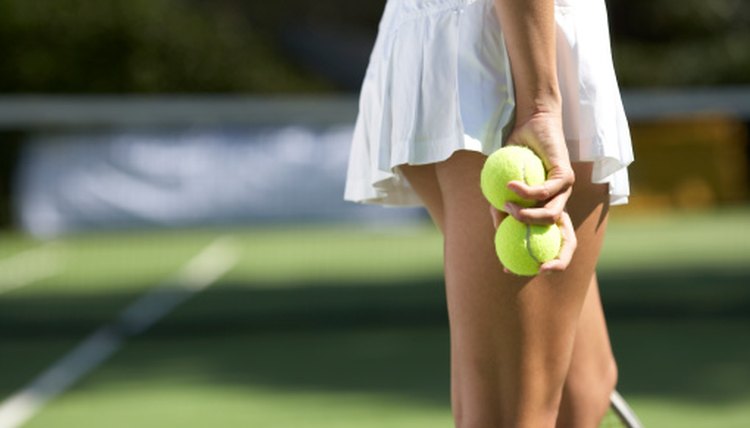Which Muscles of the Body Are Used While Playing Tennis?

Tennis is a sport that allows you to enjoy yourself while improving your physical fitness. During a tennis match, all the major muscle groups are used and the energy exertion required during play can burn over 200 calories in 30 minutes, depending on your height and weight. Tennis also requires a high amount of agility, flexibility, quick reflexes and aerobic and anaerobic conditioning.
Lower Body
Due to the swinging of the racket, tennis is often thought of as an upper-body sport, but your leg muscles, including your glutes, quadriceps, hamstrings and calves, are doing most of the work out on the court. Tennis requires several bursts of short-distance running; if you can’t get to the ball, you can't hit it back over the net. Your feet never stop moving when a ball is in play — even when your opponent has the ball. Additionally, the power for your serve, forehand and backhand originates in the legs and travels up through your body to your racket. Playing tennis will help strengthen your legs, but if you are a serious player, consider adding additional leg exercises to your workout routine such as squats, lunges and step-ups.
Core Muscles
Agility, balance and strength all come from your core — your lower back and stomach muscles — which is used during every shot and movement during a tennis match. Not only does your core connect your lower body to your upper body, most movements originate in your core. While moving forward, backward and side to side, your core helps you make quick changes in direction. A strong core keeps you balanced and stable so that you can focus on hitting the ball. In addition, every time you hit a forehand or backhand, you work your abdominal muscles, especially the obliques, which run down the sides your torso.
Upper Body
The upper back, chest, shoulders, biceps and triceps all come into play during a tennis swing or tennis serve. Although the movement begins in your legs and travels up through the core, your upper body is responsible for the final execution and follow through on the shot. While practicing and playing tennis will strengthen your upper body, conditioning these muscle groups off of the court will help your game. It is best to engage in functional exercises that will strengthen while also keep them loose and flexible. Wellness Massachusetts recommends doing seated rows, overhead presses, bench presses and lat pull-downs.
References
- Wolken D. USA Today. Working out from home: How tennis can be played safely amid coronavirus pandemic. Updated April 30, 2020.
- Mayo Clinic. Aerobic exercise: Top 10 reasons to get physical. February 5, 2020.
- Pinckard K, Baskin KK, Stanford KI. Effects of exercise to improve cardiovascular health. Front Cardiovasc Med. 2019;6:69. doi:10.3389/fcvm.2019.00069
- Oja P, Kelly P, Pedisic Z, et al. Associations of specific types of sports and exercise with all-cause and cardiovascular-disease mortality: a cohort study of 80 306 British adults. Br J Sports Med. 2017;51(10):812-817. doi:10.1136/bjsports-2016-096822
- Donnelly JE, Honas JJ, Smith BK, et al. Aerobic exercise alone results in clinically significant weight loss for men and women: midwest exercise trial 2. Obesity (Silver Spring). 2013;21(3):E219-E228. doi:10.1002/oby.20145
- Harvard Health Publishing. Calories burned in 30 minutes for people of three different weights. Updated August 13, 2018.
- Iwata M, Yamamoto A, Matsuo S, et al. Dynamic stretching has sustained effects on range of motion and passive stiffness of the hamstring muscles. J Sports Sci Med. 2019;18(1):13-20.
- National Osteoporosis Foundation. What Women Need to Know.
- National Institute of Arthritis and Musculoskeletal and Skin Diseases. NIH Osteoporosis and Related Bone Diseases National Resource Center. Exercise for Your Bone Health. Updated October 2018.
- Lauer L. United States Tennis Association. Maintain Focus & Concentration During A Match. January 1, 2017.
- Bashir SF, Nuhmani S, Dhall R, Muaidi QI. Effect of core training on dynamic balance and agility among Indian junior tennis players. J Back Musculoskelet Rehabil. 2019;32(2):245-252. doi:10.3233/BMR-170853
- Hossein-nezhad A, Holick MF. Vitamin D for health: a global perspective. Mayo Clin Proc. 2013;88(7):720-755. doi:10.1016/j.mayocp.2013.05.011
- Laird E, Rhodes J, Kenny RA. Vitamin D and Inflammation: Potential Implications for Severity of COVID-19. Ir Med J. 2020;113(5):81.
- Harinarayan CV, Holick MF, Prasad UV, Vani PS, HImabindu G. Vitamin D status and sun exposure in India. Dermatoendocrinol. 2013;5(1):130-41. doi:10.4161/derm.23873
- Savoye I, Olsen CM, Whiteman DC, et al. Patterns of ultraviolet radiation exposure and skin cancer risk: the E3N-SunExp study. J Epidemiol. 2018;28(1):27-33. doi:10.2188/jea.JE20160166
- Teo AR, Choi H, Andrea SB, et al. Does Mode of Contact with Different Types of Social Relationships Predict Depression in Older Adults? Evidence from a Nationally Representative Survey. J Am Geriatr Soc. 2015;63(10):2014-22. doi:10.1111/jgs.13667
- Umberson D, Montez JK. Social relationships and health: a flashpoint for health policy. J Health Soc Behav. 2010;51(Suppl):S54-S66. doi:10.1177/0022146510383501
Writer Bio
Beth Rifkin has been writing health- and fitness-related articles since 2005. Her bylines include "Tennis Life," "Ms. Fitness," "Triathlon Magazine," "Inside Tennis" and others. She holds a Bachelor of Business Administration from Temple University.
